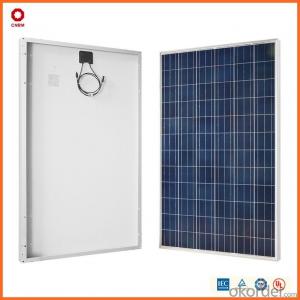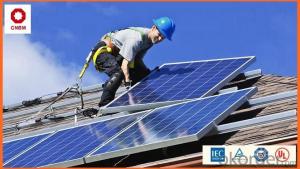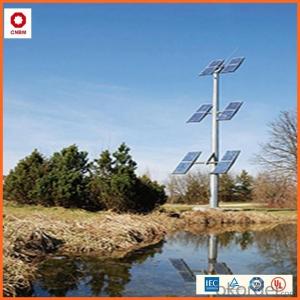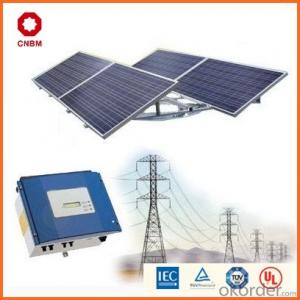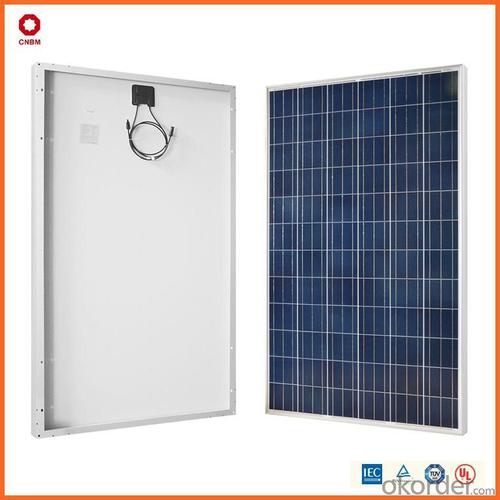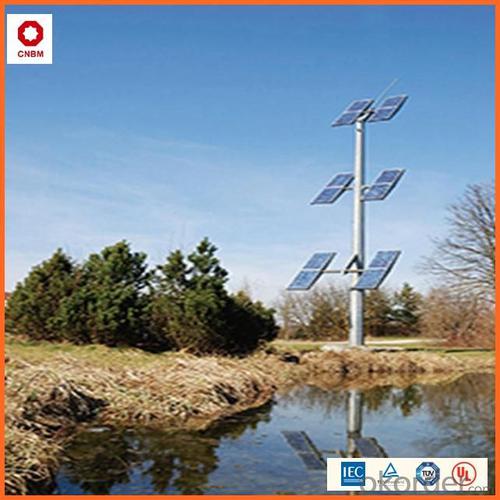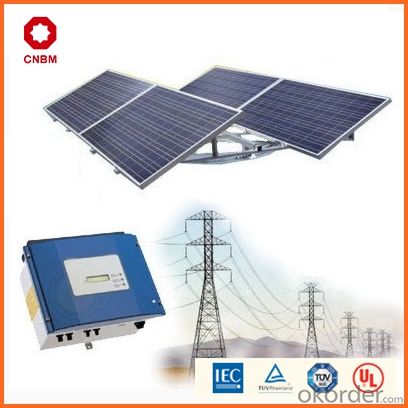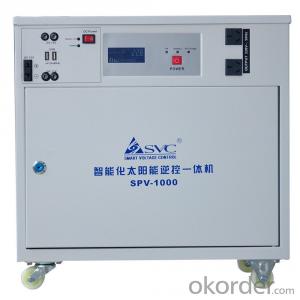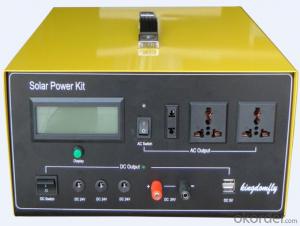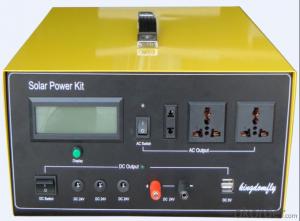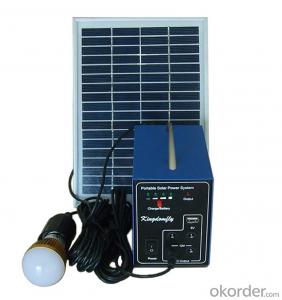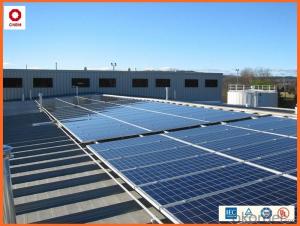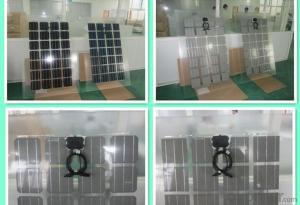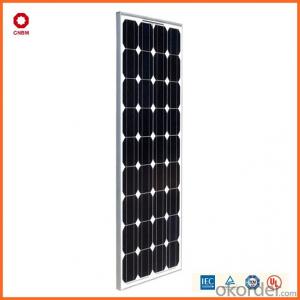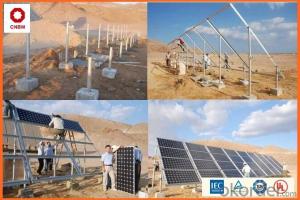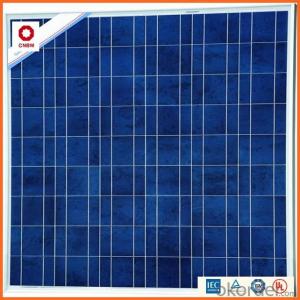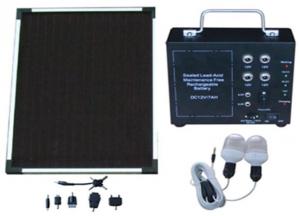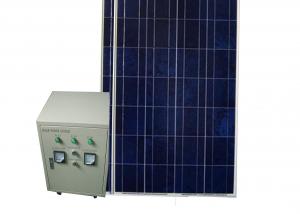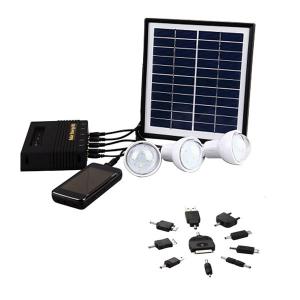Wind and Solar Energy Systems - 50w Small Solar Panels in Stock China Manufacturer
- Loading Port:
- China main port
- Payment Terms:
- TT OR LC
- Min Order Qty:
- 1 watt
- Supply Capability:
- 10000000 watt/month
OKorder Service Pledge
OKorder Financial Service
You Might Also Like
Specification
Product Description:
Hot Sale !!! Quality and Safety of Small Poly Solar Panel 5w~150w
1. Rigorous quality control meets the highest international standards.
2. High-transmissivity low-iron tempered glass, strong aluminium frame.
3. Using UV-resistant silicon.
4. IS09001/14001/CE/TUV/UL
Warranties of Small Poly Solar Panel 35~85w
1. 10 years limited product warranty
2. 15 years at 90% of the minimal rated power output
3. 25 years at 80% of the minimal rated power output
Specification
Characteristics of Poly solar panels CNBM (245-320W) | |||||
Max Power Voltage Vmp(V) | 30.3 | 30.8 | 31.1 | 31.4 | 31.85 |
Max Power Current Imp(A) | 7.60 | 7.64 | 7.73 | 7.81 | 7.85 |
Open Circuit Voltage Voc(V) | 36.1 | 36.6 | 37 | 37.3 | 37.68 |
Short Circuit Current Isc(A) | 8.50 | 8.55 | 8.65 | 8.75 | 8.85 |
Max Power Pm(W) | 230W | 235W | 240W | 245W | 250W |
Temperature Coefficient of Cells Poly solar panels CNBM (245-320W) | |
NOCT | 45± 2 |
Temperature Coeffucients of Isc | 0.0492 |
Temperature Coeffucients of Voc | -0.3374 |
Temperature Coeffucients of Voc | -0.4677 |
Mechanical Data of Poly solar panels CNBM (245-320W) | |
Dimension | 1638 × 982 × 40 mm |
Weight | 19.5 kg |
No. of Cells and Connections | 60 (6 ×10) |
Tolerance | 0 ~ + 5 W |
Cell | Monocrystalline Cell 156 × 156 mm |
Packing | 624 Pcs/40ft(H) Container |
Limits of Poly solar panels CNBM (245-320W) | |
Operating Temperature | -40 to +85 |
Storage Temperature | -40 to +85 |
Max System Voltage | 1000VDC(IEC) / 600VDC(UL) |
Features of our products:
• High conversion efficiency mono/poly-crystalline amorphous silicon solar cells
• Modules incorporate high performance bypass diodes to minimize the power drop caused by shading
• High transmittance, low-iron tempered glass
• High performance EVA encapsulant to prevent destroying and water.
• AI frame: without screw, corner connection. 8 holes on the frame can be installed easily
• Good performance of preventing from atrocious weather such as wind and hails
• Certifications: CE IEC TUV VDE UL, Class I
• 10 years 90% power output warranty
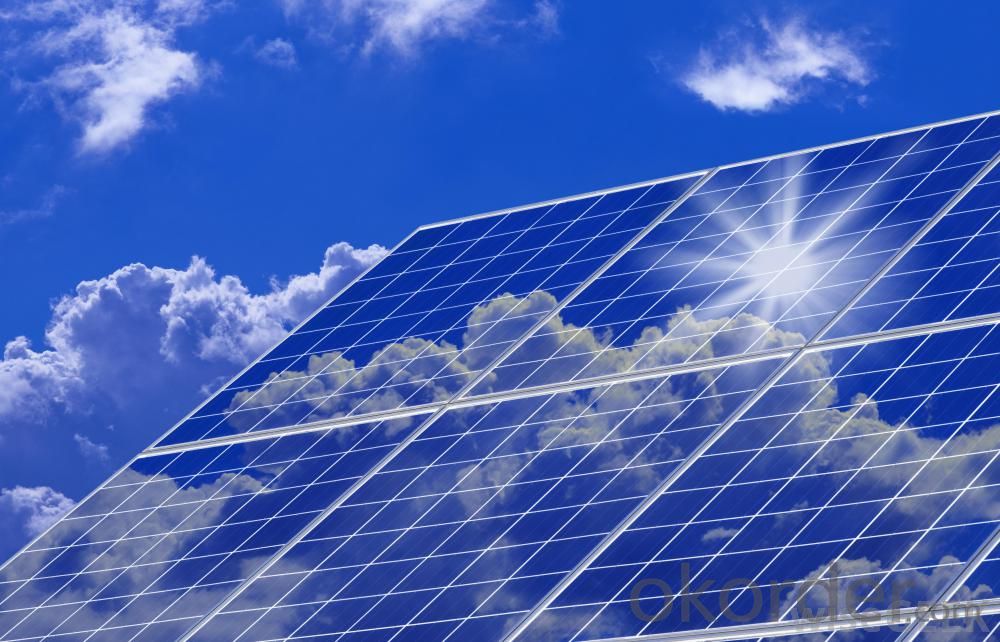
Shipping of Small Poly Solar Panel 35~85w
By Sea | Delivery from Shanghai or Ningbo seaport |
By Air | Departure from Shanghai Pudong Airport |
By Express | Post by DHL, EMS, UPS, TNT. |
Features of our products:
• High conversion efficiency mono/poly-crystalline amorphous silicon solar cells
• Modules incorporate high performance bypass diodes to minimize the power drop caused by shading
• High transmittance, low-iron tempered glass
• High performance EVA encapsulant to prevent destroying and water.
• AI frame: without screw, corner connection. 8 holes on the frame can be installed easily
• Good performance of preventing from atrocious weather such as wind and hails
• Certifications: CE IEC TUV VDE UL, Class I
• 10 years 90% power output warranty
As a professional Solar Panel manufacturer and Supplier in China, we have our customers come around the whole world and our specialization has got a worldwide recognition. Meanwhile, with our superior quality, competitive price, prompt and excellent service, As main role in trade section of CNBM Group, CNBM International Corporation supplies products including Monocrystalline Solar Panel, Polycrystalline Solar Panel ( multicrystalline silicon Solar Panel) have received and enjoyed famous reputation in many countries and regions in the world.
- Q: Can solar energy systems be used for powering electric fences?
- Yes, solar energy systems can be used for powering electric fences. Solar panels can generate electricity from sunlight, which can then be stored in batteries and used to power electric fences. This is a sustainable and cost-effective solution, especially in remote areas where access to electricity may be limited.
- Q: Are there any risks of electrical arcing with solar energy systems?
- Yes, there are risks of electrical arcing with solar energy systems. Electrical arcing can occur due to various factors such as faulty wiring, loose connections, or damaged components. This can lead to fires, damage to the system, and potential harm to individuals nearby. Therefore, proper installation, regular maintenance, and adherence to safety guidelines are crucial to minimize the risks of electrical arcing in solar energy systems.
- Q: How can I calculate the size of a solar energy system for my home?
- To calculate the size of a solar energy system for your home, you will need to consider a few factors. Here are the steps you can follow: 1. Determine your energy consumption: Start by examining your past energy bills to understand your average monthly energy usage in kilowatt-hours (kWh). This will give you an idea of how much electricity your solar system needs to generate. 2. Assess your location: The amount of sunlight your home receives depends on its location. Check the solar resource map for your region to estimate the average daily solar radiation in your area. This information will help you determine the solar panels' efficiency. 3. Calculate your energy needs: Multiply your average monthly energy usage in kWh by 12 to get your annual energy consumption. Divide this number by 365 to find your daily energy consumption. 4. Determine solar panel output: Solar panels have a wattage rating that indicates the amount of power they can generate under ideal conditions. Divide your daily energy consumption by the average daily solar radiation to estimate the number of solar panels you need. For example, if your daily energy consumption is 40 kWh and the average daily solar radiation is 5 kWh/m2, you would need an 8 kW solar system (40 kWh / 5 kWh/m2 = 8 kW). 5. Account for system losses: Solar systems experience losses due to factors such as shading, dirt, and inefficiencies in the inverter. To compensate for these losses, multiply the estimated system size by a derating factor, typically ranging from 0.75 to 0.9. This will give you the final system size you need. 6. Consult with a professional: It is always recommended to consult with a solar energy professional or installer who can conduct a site assessment and provide accurate calculations based on your specific home and energy needs. They will consider additional factors like roof orientation, available space, and local regulations to ensure an optimal solar system size for your home. Remember, the size of your solar energy system also depends on your goals, budget, and available space. A professional consultation will help you make an informed decision and maximize the benefits of solar energy for your home.
- Q: Can solar energy systems be used in areas with limited access to solar energy permits and approvals?
- Yes, solar energy systems can be used in areas with limited access to solar energy permits and approvals. While permits and approvals may be required in certain regions, there are often alternative solutions available. Off-grid solar systems, for example, can be installed in areas without needing permission from utility companies or government entities. Additionally, some areas may have simplified processes or incentives for renewable energy installations, making it easier to overcome permit limitations. It is important to consult local regulations and explore the available options to ensure compliance and maximize the use of solar energy in such areas.
- Q: What are the different financing models for installing solar energy systems?
- Installing solar energy systems offers various financing models to cater to individual preferences and financial capabilities. Here are some commonly used financing options: 1. Complete Purchase: The most direct approach is to outright purchase the solar energy system. Although it requires a significant upfront investment, it grants the homeowner or business owner full access to the benefits and incentives associated with solar energy, such as tax credits and reduced utility bills. 2. Solar Loans: Many financial institutions provide specialized loans for solar installations, offering lower interest rates and longer repayment terms compared to conventional loans. With a solar loan, the system owner makes monthly payments to the lender while enjoying the financial advantages of lower utility bills and potential tax credits. 3. Power Purchase Agreements (PPAs): A PPA involves a contract between the solar system owner and a third-party solar provider. Under this agreement, the solar provider installs and maintains the system on the customer's property, and the customer agrees to purchase the electricity generated by the system at a predetermined rate. This eliminates the need for upfront costs and allows immediate savings on the electricity bill. 4. Solar Leases: Similar to PPAs, solar leases involve a third-party solar provider installing and maintaining the system. However, instead of purchasing the electricity, the customer pays a fixed monthly lease payment for the use of the solar energy system. While this option may not provide as much savings as other financing models, it requires minimal upfront investment. 5. Property Assessed Clean Energy (PACE) Financing: PACE financing enables property owners to finance the installation of solar energy systems through an assessment on their property tax bill. The loan is repaid over a period of time, typically 10 to 20 years, through an additional assessment on the property taxes. PACE financing is particularly advantageous for property owners who may not qualify for traditional loans or prefer to spread out the cost of the solar installation over a longer duration. These examples highlight the different financing models available for installing solar energy systems. It is crucial to carefully evaluate each option, considering factors such as upfront costs, long-term savings, and individual financial goals, to determine the most suitable financing arrangement for specific circumstances.
- Q: How do solar energy systems affect the structural integrity of a building?
- Solar energy systems have minimal impact on the structural integrity of a building. These systems are usually lightweight and designed to be mounted on rooftops or integrated into existing structures. Proper installation and reinforcement measures ensure that the additional weight and stress are adequately supported, preventing any negative effects on the building's structure.
- Q: Can solar energy systems be used for powering electric boats or ships?
- Yes, solar energy systems can be used to power electric boats or ships. Solar panels can be mounted on the surface of the vessel to capture sunlight and convert it into electricity. This renewable energy source can then be used to power the boat's propulsion systems and onboard electrical equipment, reducing reliance on fossil fuels and minimizing environmental impact.
- Q: Can a solar energy system be installed on a school or university campus?
- Yes, a solar energy system can be installed on a school or university campus. In fact, many educational institutions have already embraced solar power as a sustainable and cost-effective energy solution. Installing solar panels on rooftops or in open spaces can generate clean electricity that can be used to power buildings, reduce dependence on the grid, and contribute to a greener campus. Additionally, these systems can serve as educational tools, allowing students to learn about renewable energy and environmental sustainability firsthand.
- Q: I usually have to use about 10 degrees, more in the summer! Winter sunshine time 10 hours! Who knows how much a set price, what brand?
- General installation 3000W on the line, a full set of system down 21 thousand yuan. Print-Rite used solar panels, inverter with crystal fuyuan. Guilin Jinyang PV is so safe.
- Q: Can a solar energy system be used in areas with high levels of pollution from industrial activities?
- Yes, a solar energy system can still be used in areas with high levels of pollution from industrial activities. While pollution can potentially affect the efficiency of solar panels, it does not render them completely ineffective. Solar panels can still generate electricity even in polluted areas, although their performance may be slightly reduced. It is important to note that the extent of the impact on solar panel efficiency will depend on the specific type and concentration of pollutants present in the air. Certain pollutants, such as particulate matter or smog, can cause shading or reduce the amount of sunlight reaching the solar panels, leading to a decrease in their output. Additionally, pollutants may accumulate on the surface of the panels, resulting in lower efficiency over time. However, regular maintenance and cleaning of the solar panels can help mitigate the impact of pollution. By ensuring that the panels are kept clean and free from any debris or pollutants, their efficiency can be maintained at optimal levels. Implementing cleaning schedules and utilizing advanced cleaning technologies can help minimize any potential losses in electricity generation caused by pollution. Furthermore, advancements in solar technology and panel design have made them more resilient to various environmental factors, including pollution. Manufacturers are continuously improving the durability and resistance of solar panels to external influences, allowing them to perform better in polluted environments. In conclusion, while pollution from industrial activities may have some impact on the performance of solar energy systems, they can still be effectively used in areas with high pollution levels. Regular maintenance, cleaning, and technological advancements can help mitigate any potential losses and ensure efficient electricity generation from solar panels.
Send your message to us
Wind and Solar Energy Systems - 50w Small Solar Panels in Stock China Manufacturer
- Loading Port:
- China main port
- Payment Terms:
- TT OR LC
- Min Order Qty:
- 1 watt
- Supply Capability:
- 10000000 watt/month
OKorder Service Pledge
OKorder Financial Service
Similar products
Hot products
Hot Searches
Related keywords
